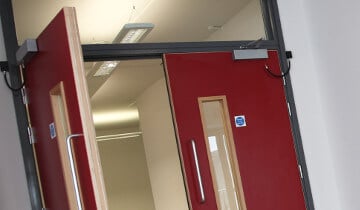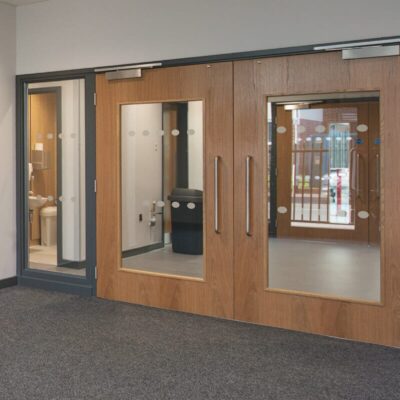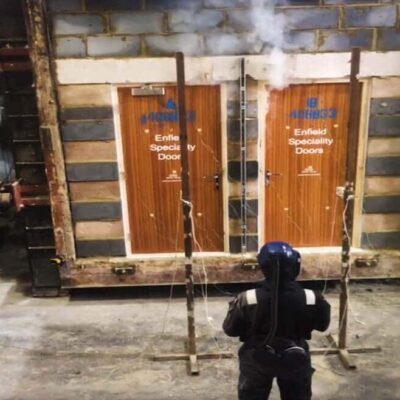Interested in our 30-minute fire doors? - Speak with our team about your requirements.
Fire door and security fire door options
There is a wide range of options available, and the type of door that you install will of course depend upon the environment where it will be situated. Clearly in all cases you need to give people the maximum time to escape and the maximum protection – which door you choose will clearly depend upon where it is located (e.g. a school, hospital, other public building, office block etc.). We provide a wide range of door sizes.
A common option is a 30 minute fire door (FD30 door). As the name implies this type of door – which we refer to as an FD30 fire door – gives 30 minutes of fire resistance, which in many situations will be sufficient time for a complete and safe evacuation.
Fire doors and security fire doors in existing buildings
These are governed by the Regulatory Reform (Fire Safety) Order 2005, often abbreviated to RRO or FSO. A useful resource is the government guide on making your premises safe from fire
This stipulates that the “responsible person” must carry out a fire safety risk assessment and then design and supervise the operation of a fire management plan.
Fire resistant doors, of course, play a crucial role in the fire safety and protection of buildings covered by the FSO.
Fire doors and security fire doors in new buildings
For new buildings, or buildings which are subject to significant alterations, extensions, or changes of use, the appropriate building regulations apply for fire doors. These regulations are known as Approved Documents.
These approved documents are designed to ensure that minimum standards are met for construction in the UK, and cover areas such as accessibility, ventilation, sound and thermal efficiency as well, of course, as fire safety.
Modern buildings are compartmentalised to delay the spread of fire from one area to another. The fire doors that link these compartments have two very important functions:
- when closed they form a barrier to stop the spread of fire
- when opened they provide a means of escape
Every fire door is therefore required to act as a barrier to the passage of smoke and/or fire to varying degrees depending upon its location in a building, the fire hazards associated with that building, and the function of the building (e.g. a school, library, office etc.)
Specifying the correct fire door can be a life or death responsibility – figures from 2013-14 (the latest year for which comprehensive data is available) reveal the following sobering facts:
- The total number of fires attended was 212,500
- There were 322 fire-related deaths
- 41% of fire-related deaths were caused by the victim being overcome by gas, smoke or toxic fumes. The other leading causes are burns alone (20%) and combination of burns and being overcome by gas or fumes (20%)
- There were 9,748 non-fatal casualties in fires
It’s important to be aware of the fact that roughly 1 in 12 fires spread from where the fire started to other rooms in the building; this is where fire doors come in, and this is where we need to ensure that the correct “rating” is fitted.

Fire door and security fire door ratings explained
Fire doors and doorsets are tested to BS 476 Part 22 to represent how they will function in a fire, and are rated in minutes and prefixed by the letters FD. Hence the table to the right.
Note that we mentioned doorsets there – the building regulations in operation relate to the entire door installation, and not just the door alone. Because of this, fire doors are not tested as individual leaves, but as a complete installation, along with frame, locks, latches and other essential ironmongery.
| Fire door rating | Fire door |
| 30 minutes | FD 30 |
| 60 minutes | FD 60 |
| 90 minutes | FD 90 |
| 120 minutes | FD 120 |
| 240 minutes | FD 240 |
Fire doors, security fire door and their specifications
The first thing to say is that there are different products available for different risks – our fire door range starts from 30 minute right through to a 240 minute (steel) fire door. Clearly in all cases you need to give people the maximum time to escape and the maximum protection – which door you choose will clearly depend upon where it is located (e.g. a school, hospital, other public building, office block).
It’s not all about the door either. You need to consider the frame, and also the finish – options include:
- Wood Veneer
- Plain, Pattern or Wood Grain Laminate
- Primed Finish
- Paint Grade for on-site painting
- Fire doors with glass
And what if you need to see through the door? Many clients want an integrated fire-rated glass opening or glazed screen, and this is possible too, meeting or surpassing British fire resistance standards (which we went through in a recent article).
Let’s now look at some details of one of our 30 minute fire doors:
- 44mm Certified core to BS 476 Pt22:1987 or BS EN 1634-1:2014
- Intumescent strips in the frame or the door (not both) (see below)
- Certified glazing (insulating / non insulating)
Notes:
- Available as a pre hung assembly
- Must be installed by a competent person
- If a 2 storey building has a door leading from an integral garage into the house then it must be a fire resistant door.
- New build or renovated properties with 3 story’s or more, including loft conversions, must have a fire doors to every habitable room off the stairwell
The balancing act
First and foremost – and obviously – it’s imperative that the fire doors installed perform their primary functions perfectly i.e. preventing as far as possible the spread of fire and smoke while allowing people to evacuate quickly and safely (and facilitating the safe entry/exit of fire-fighters if they are called out).
That said, and without any compromises, it’s clearly unnecessary to install, say, a four hour fire door when a 30 minute one will suffice.
It could be that the risk of fire is very great, and/or that the consequences of a fire in that environment would be terrible. All fires, where there is risk to life and property, are potentially terrible – but some are clearly more terrible than others. It’s a question of scale.
As we said at the time, obviously the safety of the two library staff is no less important than the safety of the hundreds of people in the fireworks factory or the workers in the MOD site or children in a school, but clearly the different environments necessitate different measures. Considerations include:
- how many people would need to be evacuated in the event of a fire
- what sort of building is it (e.g. skyscraper or small library) i.e. how quickly could everyone get out
- what surrounds the building (e.g. isolated rural location or city centre)
- what is IN the building that we wouldn’t want the fire to get to – such as valuable items.
- overall, what would the consequences be of a fire breaking out in terms of human life, public safety, loss of property or material etc.
Don’t forget, also, you’ll need to take into consideration additional requirements if members of the public may need to use the doors.
There’s no point over-specifying the fire door and incurring unnecessary costs if it simply isn’t necessary. This in no way implies that we should take shortcuts on safety – simply that we get the right door for the job.

Interested in our 30-minute fire doors? - Speak with our team about your requirements.
Intumescent seals
An important component of an effective fire resistant door is the seal – think about the gap that would otherwise exist around the door, potentially allowing fire and smoke to escape.
So-called “intumescent seals” are designed to expand under heat, filling the gap between the door leaf and its frame, and therefore preventing the passage of smoke and fire to other parts or compartments of the building.
These seals may be placed into grooves machined in the two vertical sections and top edge of the door frame. When exposed to heat, they expand to many times their original size, sealing the gap between the door and the frame, and aiding containment of the fire.
The materials contained in the seals, (such as sodium silicate or graphite), differ between seal manufacturers, and expand at different rates. It’s important to use the same type of seals around the door when installing or replacing seals, so make sure you check with the experts.
General fire safety advice
In an ideal world fire doors would only be an insurance policy. This being the case, there are some simple steps we can take to prevent as far as possible fires starting in the first place:
Do's
- Regularly check the condition of your wiring
- Check your sockets regularly – if you see burn marks or they feel hot, get a registered electrician to check them
- Turn off any electrical equipment you are not using – especially at night, when a fire can spread quickly while there is no-one around
- Regularly check flexible cables – look for signs of fraying, general wear and tear, or a loose plug. Do this before you plug anything in
- Check the current rating of an electrical adaptor before you plug appliances in – make sure that the total current used does not exceed the adaptor’s rating
- Call the Fire and Rescue Service immediately if you smell burning that cannot be explained. They will have equipment such as thermal imaging cameras which will accurately detect objects that are overheating
Dont's
- Overload any adaptor or socket – especially with appliances that have a high electrical current. It’s far safer to have extra sockets installed if needed
- Put electric heaters near curtains or furniture
- Cover the air vents on storage heaters or fan heaters
- Trail flexible cables under carpets or rugs
- Exceed the wattage of the light fitting or lampshade with the bulb you use
- Cover the air vents on storage heaters or fan heaters
- Store combustible materials (clothes, papers, cleaning materials etc) close to your service head (cut-out fuse), electricity meter or fusebox.
If the worst does happen and a fire breaks out, internal doors play a vital role not only in slowing down the spread of the fire but enabling people to evacuate quickly and safely.









